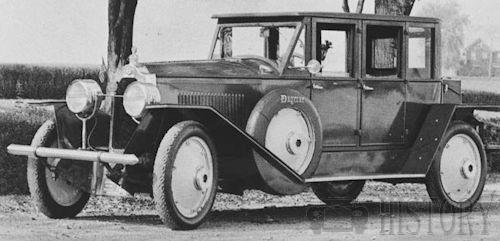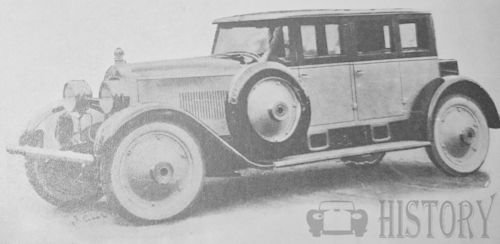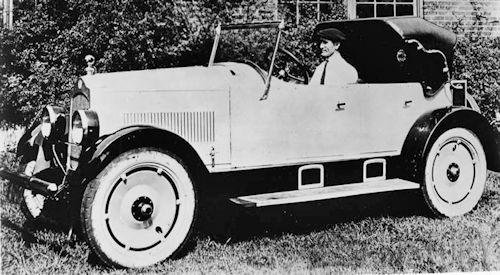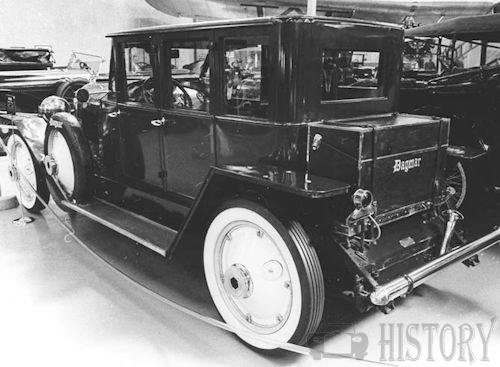Dagmar (MP Moller Motor Car Company)

The MP Moller Motor Car Company (Dagmar) automobile production company was in Hagerstown, Maryland.
History
Mathias Peter Møller from Denmark acquired a majority stake founded from 1904 to 1921 the Crawford Automobile Company and led the brand Dagmar from 1922 to 1924 he renamed the company to MP Moller Motor Car Company .
In 1926, a huge, seven-seater sedan was built for Moller himself, who used this in 1927 for an extended trip to Europe. Thus ended the production of complete automobiles in Hagerstown , the taxi production was still running in Framingham until 1931.The company continued to manufacture taxi cabs and special bodies for trucks on customer request until the mid-1930s.
The co-producing Moller Motor Company in Lewistown, Pennsylvania, and a short time in Hagerstown, Maryland, have no business or family ties.

1924 Dagmar petite 6-70.
By 1925, a smaller Dagmar was placed on the market, also powered by a smaller Continental engine.The Dagmars were actually the Crawford car with sport treatment and were named for the daughter of M.p. Möller.
Dagmar
The six-cylinder model 6-70 Sport-Victoria (2-door touring car) was the sporty counterpart to the technically same, more luxurious Crawford model 6-70. Both had the same 70 hp Continental six-cylinder engine and the same 3505 mm wheelbase. Unlike the Crawford Dagmar edged sculpted wings were made of flat sheets instead of the usual rounded. At the time, that was considered particularly fashionable; but there were also less extravante, rounded available.
Both models were initially manufactured in parallel at Crawford. The new car Moller had named after his second daughter (Mary) Dagmar and probably also after the popular in Denmark Queen Dagmar of Bohemia . In memory of his old home Denmark Dagmar contributed to 1924 the emblem of the Danish royal family . Then it could no longer be used at the behest of the Danish royal family. Another controversy came with Packard because Moller red hexagons had installed on the hub caps of Dagmar as a registered trademark of Packard Motor Car Company were protected. On the other hand, Packard could not take action against the almost three-staged copy of the radiator grille because it was not a registered trademark. In 1923, 135 copies produced most Dagmar in one production year.
In March 1924 Moller gave up the brand Crawford. The production of the Dagmar vehicles - all six-cylinder - was never economically justifiable and could be maintained as a "hobby horse" of the owner only because its well-established organ building company for many years dropped enough profit.
Luxor Cab Manufacturing Company
Also in 1924 Moller invested with the New York businessmen Allie S. Freed and Mickey Heidt in a new venture to manufacture particularly luxurious taxis. The Luxor Cab Manufacturing Company was founded in Hagerstown, but moved the production but after a few weeks to Framingham ( Massachusetts ) in the plants of the RH Long Company , manufacturer of the Bay State .
Some copies of the Luxor were completed in Hagerstown, by far the largest part was created at the new domicile in Framingham. The production ended in 1927. The company introduced from 1924 to 1925 and the Standish ago, a version of Luxor for private clients.
1925 Baby Dagmar 6-60

Powered by a continental 6-cylinder engine, additional body styles were added in 1923 and a year later, conventional fenders were available as an alternative to the straight type.
Taxi Brands
Moller set up a car rental business and relied on producing small series of taxis to avoid having to cease production of the Dagmar . These were sold under different names. The brands Luxor and Standish , however, came from Luxor.
The multitude of brands was created because some major customers required vehicles with a brand name reserved exclusively for them. Outwardly and in the equipment there were differences such as pointed or flat cooler, technically these vehicles hardly differed.
The conventional and more or less the same chassis received Buda-four-cylinder engines with WTU 226.4 ci (3710 cm³) , and later six-cylinder. 1926 presented Möller to the Continental six-cylinder, also for Dagmar and the Standish were used. With the latter was tried in 1924 unsuccessful to derive from the Luxor a car. This was abandoned in 1925; the freed-up capacity was used for the Elysee , which was manufactured as a panel van specifically for the needs of upscale shops and was both a delivery van and an advertising medium.
Aristocrat :This brand existed from 1927 to 1931. The engine came from Buda. Astor :This brand existed from 1925 to 1927. The wheelbase was 300 cm. A four-cylinder engine from Buda powered the vehicles. Limousine and Landaulet are handed down. The Astor Cab Sales Company, Inc. of New York City marketed the vehicles. Many were sold to Philadelphia. Blue Light:This was introduced in 1927 and abandoned around 1931. A Buda engine powered the vehicles. The only market was Baltimore in Maryland. Five Boro:This was the first taxi. It existed from 1924 to 1927. The chassis had 300 cm wheelbase. An engine from Buda powered the vehicles. The vehicles were used in New York City. The name alludes to the five boroughs of New York (Bronx, Brooklyn, Manhattan, Queens, Staten Island). Paramount :The Paramount Cab Manufacturing Company of New York City marketed these vehicles from 1927 to 1931. They were luxuriously appointed. Some vehicles were sold than cars to individuals.Super Paramount :These vehicles were also from 1927 to 1931. They were the super-luxury version of the Paramount. Twentieth Century:This brand existed from 1925 to about 1927. The main market was Philadelphia
1922 Dagmar Sport Sedan rear view
Technical
-
Dagmar Models (1922-1931)
model
NACC Rating
Construction year
engine
Displacement cm³
horsepower
Power kW
Wheelbase mm
bodies
Dagmar 6-70
31.5 HP
1922
6 Series, sv , Continental 6T
4313
70
51
3505
Sport Victoria 2 doors
Dagmar 6-70
31.5 HP
1923
6 row, sv, Continental 6
4313
70
51
3505
Sport Victoria 2 doors
Dagmar 6-70
31.5 HP
1924
6 Series, sv, Continental 6T
4313
70
51
3505
Sport Victoria 2 doors
sedan 4 doorsDagmar 6-70
33.7 HP
1925
6 Series, sv, Continental 6J
5424
70
51
3505
Roadster 4 Pl.
Sport-Touring 4 Pl.
Tourer 6 Pl.
Coupe Del./Petite 4 Pl.
Phaeton
Petite Lim. 4 Pl.
Sedans 5/7 Pl.Dagmar 6-70
33.7 HP
1926
6 Series, sv, Continental 6J
5424
70
51
3505
Roadster 4 Pl.
Sport Tourer 4 Pl.
Coupé Del./Petite 4 Pl.
Phaeton
Petite Lim. 4 Pl.
Sedans 5/7 Pl.Dagmar 6-70
33.7 HP
1927
6 row, sv, Continental 6J
5424
3505
Roadster 2 Pl.
Sport Touring 4 Pl.
Touring5 Pl.
Sedan 5 Pl.Dagmar 6-80
1925
6 Series, sv, Continental
80
59
3505
Sport Victoria 2 doors
sedan 4 doorsDagmar 6-80
1926
6 Series, sv, Continental
80
59
3505
Sport Victoria 2 doors
sedan 4 doorsDagmar 6-60
25.3 HP
1925
6 Series, sv, Continental 8R
3966
60
44
2997
Roadster 2 doors
Sport-Victoria 2 doors
Touring 5 doors
Coupe 2 doors
Sedan 4 doorsDagmr 6-60
a25.3 HP
1926
6 row, sv, Lycoming 4S
3671
60
44
3048
Sport Touring 4 Pl.
Touring 5 Pl.
Sedan 5 Pl.Dagmar 6-60 Deluxe
25.3 HP
1927
6 row, sv, Lycoming 4S
3671
60
44
3048
Roadster 4 Pl.
Sport Tourer 4 Pl.
Coupé Del./Petite 4 Pl.
Phaeton
Petite Lim. 4Pl.
Limousines 5/7 Pl.Luxor Taxicab Series L
22.5 HP
1925
4 Series, sv, Buda WTU
3703
2896
Taxi sedan
Taxi LandauletLuxor Taxicab Series L
22.5 HP
1926
4 Series, sv, Buda WTU
3703
2896
Taxi sedan
Taxi Landaulet



